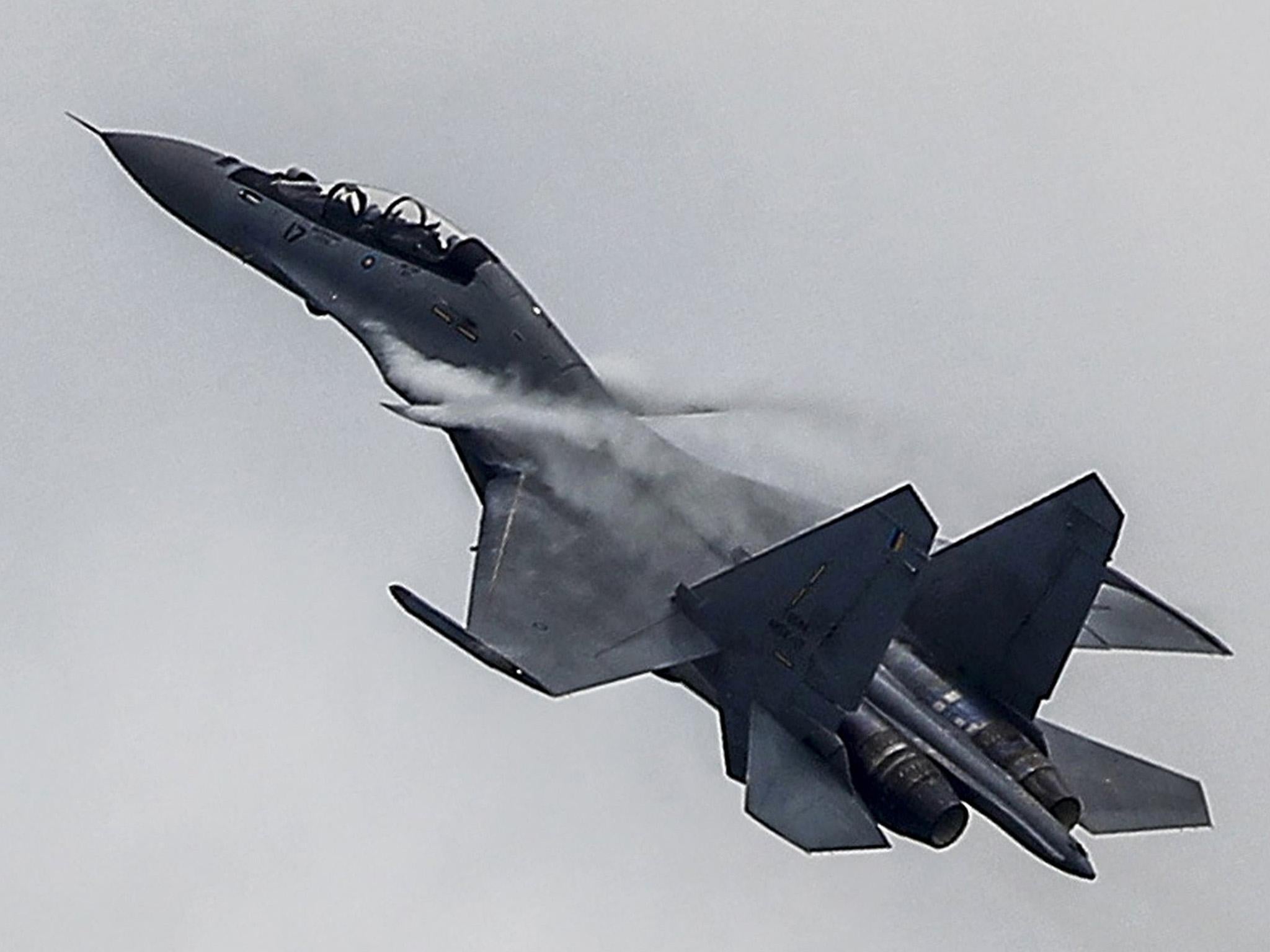‘They have enough to destroy both countries’: How an arms race is adding deadly fuel to fire of decades-old Armenia-Azerbaijan conflict
Warring neighbours once sparred with small arms and Soviet-era mortars. But escalating arms purchases mean both countries now have formidable arsenals of modern tanks, howitzer artillery cannons, unmanned drones and sophisticated aircraft, as Borzou Daragahi reports


The advanced Russian Su-30SM fighter jets were overkill, critics said, and much more than the tiny republic of Armenia needed for its defence. But the previous government in Yerevan had committed to purchase up to a dozen from Russia on extremely favourable payment terms, despite maintenance and training costs. The last thing the new government of prime minister Nikol Pashinyan needed was more trouble with the Kremlin, which had been the primary patron of his predecessor.
But the fighter jets took on a whole new significance in April, when Armenia’s neighbour and arch-rival Azerbaijan also announced its intention to purchase Su-30SM fighter jets, manufactured by Russia’s Sukhoi Aviation at a cost of around $50m each.
By mid-July, when fighting broke out between Armenia and Azerbaijan, the fighter jets derided by some as a gratuitous boondoggle were scrambled into action, screeching over the conflict zone.
The 30-year conflict between the two nations, fought primarily over the breakaway Nagorno-Karabakh enclave, was first waged with small arms and rusting Soviet-era mortars. But thanks to years of arms purchases, both countries now have formidable arsenals of modern tanks, howitzer artillery cannons, unmanned drones and sophisticated anti-aircraft units – making any confrontation far more potentially catastrophic.
“A greater amount of weapons that have greater destructive capacities make the conflict more dangerous,” says Peter Liakhov, editor of OC Media, a news platform which focuses on the Caucasus. “In the early 1990s, there was a lot of trench warfare and people with assault rifles. I would be scared to imagine what open warfare would look like with the arsenal of weapons these two countries now have.”
Armenia and Azerbaijan’s seemingly intractable conflict is rooted in century-old Communist social-engineering schemes. The ethnic and nationalistic tensions spilled over into all-out war (1992-1994) between the newly independent states over the Nagorno-Karabakh enclave – a landlocked 1,700-square-mile piece of territory controlled by Armenia, with a population of 3 million, but surrounded and claimed by Azerbaijan, a nation of 9 million people.
There has been sporadic fighting over the enclave for decades. A war in 2016 led to more than 100 deaths, mostly military personnel but some civilians. Each side accused the other of sparking the fighting. Armenia launched mortars and rockets. Azerbaijan dispatched fighter jets and tanks. Each side dispatched drones. Russia quickly brokered a ceasefire, and the fighting ended in days.
But the newly acquired firepower purchased from world powers by both countries has raised the stakes of any conflict, raising fears that a fresh outbreak of fighting could be devastating.
The clashes which erupted on 14 July also had murky origins, with each side blaming the other for sparking the conflict. The fighting left some 17 dead and displaced hundreds of families. Among those killed were top-ranking Azerbaijani officers, including a popular general. More significantly, the fighting took place some 200 hundred miles northwest of Nagorno-Karabakh, in the adjacent Tovuz and Tavush districts, suggesting a broadening of the conflict.
“This was unique and important, because it’s not just over Nagorno-Karabakh anymore,” said Richard Giragosian, director of the Regional Studies Centre, a think tank in Yerevan, and a former US Senate staffer. “This was Armenia vs Azerbaijan.”
Though it lasted only a few days, it quickly threatened to veer out of control. During the fighting, Azerbaijan’s defence ministry spokesperson Vagif Dargahli boasted that Baku’s precision missiles, some of the most advanced of which it obtained from Israel in 2018, are capable of targeting Armenia’s Russian-built Metsamor nuclear power plant, “which could lead to a great catastrophe for Armenia”.
Crucial Azerbaijani energy, communications and transport infrastructure runs through Tovuz, and Armenia could have easily targeted pipelines and roads.
I would be scared to imagine what open warfare would look like with the arsenal of weapons these two countries now have
Two days after Azerbaijan and its staunch ally Turkey held long-scheduled 29 July war games, Armenia announced surprise military preparedness drills. On the Friday, Armenia’s defence minister visited Nagorno-Karabakh, showing off a new mobile ballistic missile system deployed to the enclave.
“At any moment a conflict can cause great instability,” says Hikmat Hajiyet, an adviser to Azerbaijani president Ilham Aliyev. “We see continued military purchases by the Armenian side with the sole purpose of maintaining the status quo of occupation.”
But Armenians accuse Azerbaijan of being the primary generator of the conflict, with Baku refusing to accept the terms of the 1994 Bishkek Protocol which ended years of fighting. “Broadly speaking you have two countries of which one is not satisfied with the status quo,” says Alex Melikishvili, a principal research analyst at IHS Markit, a business intelligence firm based in London.
In recent years both countries have increased their military expenditures. Oil-and-gas rich Azerbaijan’s spending on its armed forces has jumped to an all-time high of nearly $1.854bn in 2019. Armenia’s military outlays totalled a record $647m in 2019, nearly five per cent of GDP and among the highest in the world.
“There has been an arms race in the south Caucasus for a very long time,” says Melikishvili. “What we witnessed was a significant uptick in military conflict. The arms trade certainly doesn’t help.”

Experts say each country has more than enough firepower to wreak havoc on each others’ capitals and major infrastructure in an all-out war. Azerbaijan has some advantages as it is able to purchase advanced weaponry at market prices from Israel, Turkey and Belarus. But Armenia, a member of the Moscow-led Collective Security Treaty Organisation, can buy Russian weapons at significant discounts.
“What they have is enough to destroy both countries,” says Olesya Vartanyan, Caucasus specialist at the Crisis Group, a conflict-resolution advocacy organisation based in Brussels.
Even as Russians and others sell both countries weapons, despite a request by the Organisation for Security and Cooperation in Europe to refrain from such transfers, few if any countries have an interest in seeing all-out war in the Caucasus. Russia thrives off frozen conflicts such as those in Nagorno-Karabakh, and other similar enclaves in Ukraine and Moldova, where it can exercise leverage and influence, and provide a haven for its operatives to launder money and sell weapons.
“Russia’s goal first of all is to make money,” says Matthew Bryza, a former US ambassador to Azerbaijan. “They don’t want the conflict to spin out of control. They want to keep the conflict simmering but not boiling over.”
The latest additions to Azerbaijan’s arsenal include Israeli SkyStriker combat drones capable of long-range kamikaze strikes. Other recent purchases include Israeli ballistic missiles and surveillance drones, Belarusian tactical missile launchers, Pakistani military training aircraft, Turkish armoured vehicles and anti-drone systems, South African sniper rifles, and Russian BTR-82A personnel carriers.
In addition to the Sukhoi fighter jets, Armenia recently acquired two advanced Russian surface-to-air missile systems.
“Both sides have ballistic missiles,” says Melikishvili. “Both sides can target each others’ critical infrastructure. Neither has a robust air defence that would protect them”.
Adding to the risk of a conflict are domestic pressures in both countries. Armenia’s new government, which came to power after 2018 protests against the country’s longtime ruler, has been struggling to find its footing amid economic troubles, strained diplomatic ties with the Kremlin, and the worst coronavirus outbreak in the Caucasus. Azerbaijan is suffering under the weight of domestic discontent over low prices for energy, the lifeblood of its economy. The fighting prompted protesters in Baku to demand the resignation of the defence minister for incompetence and corruption.
“The government is showcasing these weapons and armaments that they have been buying from Israel and Turkey,” says Arzu Geyballa, an Azerbaijani journalist and commentator. “But what we’re seeing is the military servicemen still fighting with outdated machinery. Where are the funds actually spent?”
Illustrating the passions the conflict arouses, clashes between diaspora communities from both sides broke out in London, Brussels, Moscow, and Los Angeles.
Far from rich foreign capitals, along the front lines between Azerbaijan and Armenia the conflict causes little but misery, reinforcing a trend of urban migration and brain drain. Once neighbours and friends, an entire generation of Armenians and Azerbaijanis has grown up without knowing each other except as enemies and strangers.
“People live right next to the trenches,” says Vartanyan. “When you wake up in the morning, you hear soldiers shouting in another language. This is a kind of human tragedy because you have to live with something that started long before you were born and you understand that it will not get resolved in your lifetime.”
Join our commenting forum
Join thought-provoking conversations, follow other Independent readers and see their replies
Comments